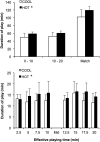Thermal, physiological and perceptual strain mediate alterations in match-play tennis under heat stress
- PMID: 24668377
- PMCID: PMC3995247
- DOI: 10.1136/bjsports-2013-093063
Thermal, physiological and perceptual strain mediate alterations in match-play tennis under heat stress
Abstract
Objectives: This study compared the thermal, physiological and perceptual responses associated with match-play tennis in HOT (∼34°C wet-bulb-globe temperature (WBGT)) and COOL (∼19°C WBGT) conditions, along with the accompanying alterations in match characteristics.
Methods: 12 male tennis players undertook two matches for an effective playing time (ie, ball in play) of 20 min, corresponding to ∼119 and ∼102 min of play in HOT and COOL conditions, respectively. Rectal and skin temperatures, heart rate, subjective ratings of thermal comfort, thermal sensation and perceived exertion were recorded, along with match characteristics.
Results: End-match rectal temperature increased to a greater extent in the HOT (∼39.4°C) compared with the COOL (∼38.7°C) condition (p<0.05). Thigh skin temperature was higher throughout the HOT match (p<0.001). Heart rate, thermal comfort, thermal sensation and perceived exertion were also higher during the HOT match (p<0.001). Total playing time was longer in the HOT compared with the COOL match (p<0.05). Point duration (∼7.1 s) was similar between conditions, while the time between points was ∼10 s longer in the HOT relative to the COOL match (p<0.05). This led to a ∼3.4% lower effective playing percentage in the heat (p<0.05). Although several thermal, physiological and perceptual variables were individually correlated to the adjustments in time between points and effective playing percentage, thermal sensation was the only predictor variable associated with both adjustments (p<0.005).
Conclusions: These adjustments in match-play tennis characteristics under severe heat stress appear to represent a behavioural strategy adopted to minimise or offset the sensation of environmental conditions being rated as difficult.
Keywords: Fatigue; Thermoregulation.
Figures




Similar articles
-
Coping with heat stress during match-play tennis: does an individualised hydration regimen enhance performance and recovery?Br J Sports Med. 2014 Apr;48 Suppl 1(Suppl 1):i64-70. doi: 10.1136/bjsports-2013-093242. Br J Sports Med. 2014. PMID: 24668383 Free PMC article.
-
Autonomic and behavioural thermoregulation in tennis.Br J Sports Med. 2008 Aug;42(8):679-85; discussion 685. doi: 10.1136/bjsm.2007.042499. Epub 2007 Nov 29. Br J Sports Med. 2008. PMID: 18048434
-
Air temperature and physiological and subjective responses during competitive singles tennis.Br J Sports Med. 2007 Nov;41(11):773-8. doi: 10.1136/bjsm.2007.036996. Epub 2007 Jul 23. Br J Sports Med. 2007. PMID: 17646242 Free PMC article.
-
Effects of thermal stress during rest and exercise in the paediatric population.Sports Med. 1998 Apr;25(4):221-40. doi: 10.2165/00007256-199825040-00002. Sports Med. 1998. PMID: 9587181 Review.
-
Hydration and thermal strain during tennis in the heat.Br J Sports Med. 2014 Apr;48 Suppl 1(Suppl 1):i12-7. doi: 10.1136/bjsports-2013-093256. Br J Sports Med. 2014. PMID: 24668373 Free PMC article. Review.
Cited by
-
Consensus Recommendations on Training and Competing in the Heat.Sports Med. 2015 Jul;45(7):925-38. doi: 10.1007/s40279-015-0343-6. Sports Med. 2015. PMID: 26002286 Free PMC article. Review.
-
Pre-, Per- and post-cooling strategies used by competitive tennis players in hot dry and hot humid conditions.Front Sports Act Living. 2024 Sep 18;6:1427066. doi: 10.3389/fspor.2024.1427066. eCollection 2024. Front Sports Act Living. 2024. PMID: 39359487 Free PMC article.
-
Application of evidence-based recommendations for heat acclimation: Individual and team sport perspectives.Temperature (Austin). 2018 Oct 13;6(1):37-49. doi: 10.1080/23328940.2018.1516537. eCollection 2019. Temperature (Austin). 2018. PMID: 30906810 Free PMC article. Review.
-
Competitive match-play tennis under heat stress: a challenge for all players.Br J Sports Med. 2014 Apr;48 Suppl 1(Suppl 1):i1-3. doi: 10.1136/bjsports-2014-093496. Br J Sports Med. 2014. PMID: 24668372 Free PMC article. No abstract available.
-
Heat research guides current practices in professional tennis.Br J Sports Med. 2014 Apr;48 Suppl 1(Suppl 1):i5-6. doi: 10.1136/bjsports-2013-093272. Br J Sports Med. 2014. PMID: 24668380 Free PMC article. No abstract available.
References
-
- Saltin B, Hermansen L. Esophageal, rectal, and muscle temperature during exercise. J Appl Physiol 1966;21:1757–62 - PubMed
-
- Lind AR. A physiological criterion for setting thermal environmental limits for everyday work. J Appl Physiol 1964;18:51–6 - PubMed
-
- Périard JD, Cramer MN, Chapman PG, et al. Cardiovascular strain impairs prolonged self-paced exercise in the heat. Exp Physiol 2011;96:134–44 - PubMed
-
- Rowell LB. Human cardiovascular adjustments to exercise and thermal stress. Physiol Rev 1974;54:75–159 - PubMed
-
- Ozgünen KT, Kurdak SS, Maughan RJ, et al. Effect of hot environmental conditions on physical activity patterns and temperature response of football players. Scand J Med Sci Sports 2010;20:140–7 - PubMed
Publication types
MeSH terms
LinkOut - more resources
Full Text Sources
Other Literature Sources
